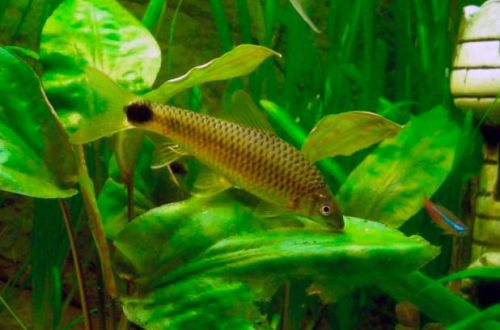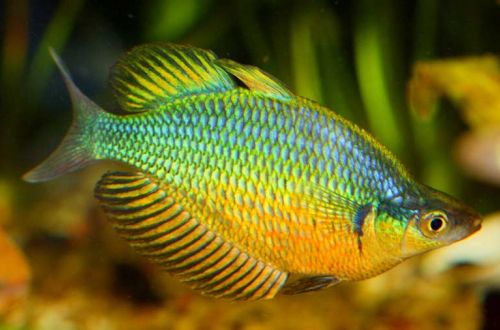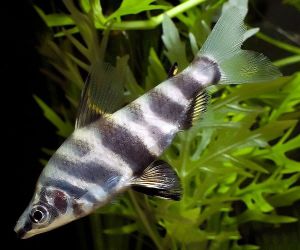
Rasbora Nevus
Rasbora Nevus or Strawberry Rasbora, scientific name Boraras naevus, belongs to the Cyprinidae family. It belongs to one of the smallest aquarium fish. Easy to keep, compatible with other non-aggressive species of comparable size. May be recommended for beginner aquarists.
Contents
Habitat
It comes from Southeast Asia from the Malay Peninsula, the territory of modern Thailand and Malaysia. Inhabits swamps and lakes with dense aquatic vegetation. The natural habitat is characterized by clear water, rich in tannins, which is why it is often painted in a brownish color. At present, the natural habitat of this species has practically disappeared, giving way to agricultural land (rice fields).
Brief information:
- The volume of the aquarium – from 40 liters.
- Temperature – 20-28°C
- Value pH — 5.0–7.0
- Water hardness – soft (1-10 dGH)
- Substrate type – any
- Lighting – subdued / moderate
- Brackish water – no
- Water movement – weak or stagnant
- The size of the fish is 1.5–2 cm.
- Food – any food
- Temperament – peaceful
- Keeping in a group of 8-10 individuals
Description
Adults reach only two cm in length, making them one of the smallest aquarium fish. The coloration is bright red with black dots, and the color saturation is higher in males, which also have a larger spot on the abdomen.
Food
Undemanding to the diet look. Accepts most popular suitable sized foods such as flakes and pellets combined with brine shrimp. It is recommended to use foods rich in protein, which contributes to the development of the best color.
Maintenance and care, arrangement of the aquarium
Such a modest size makes it possible to keep a flock of Rasbor Nevus in small tanks, the so-called nano-aquaria from 20–40 liters. The design is arbitrary, provided that there is a large amount of aquatic vegetation, including floating ones. Plants serve not only as a reliable shelter, but also as a means of shading and scattering light.
Standard and regular maintenance procedures for the aquarium (cleaning the substrate, glass and decorative elements, changing the water, checking equipment, etc.), coupled with a productive filtration system, allow you to maintain optimal conditions. When choosing a filter, it must be remembered that it is the main source of flow, and this type of fish does not tolerate excessive water movement, so it is recommended to consult a specialist and choose the right model. A simple airlift filter with a sponge can be a win-win option.
Behavior and Compatibility
Peaceful calm schooling fish. It is recommended to keep in a group of 8-10 individuals, especially in the company with other species, so Strawberry Rasbora will be less shy. Compatible with other non-aggressive and small fish.
Breeding / breeding
In favorable conditions, spawning will occur regularly. However, growing fry is not so easy. This species has no parental instincts, so adult fish can quickly eat their own caviar and fry. In addition, one of the problems will be finding a suitable microfeed.
Despite the dangers that await the fry in the general aquarium, in some cases some of them are able to grow to an adult state – thickets of plants will serve as a good shelter, and at the first stage, ciliates of the shoe will serve as food, which are often invisibly present in the substrate of a mature aquarium.
If you plan to raise the entire brood, then the eggs or juveniles must be caught in a timely manner and transplanted into a separate tank with identical water conditions, where they will grow in complete safety. This separate spawning aquarium is equipped with a simple airlift filter with a sponge and a heater. In the first months of life, a separate lighting system is not required. Shade-loving plants from ferns and mosses are used in the design.
Fish diseases
In a balanced aquarium biosystem with suitable water conditions and regular maintenance, fish health problems usually do not occur. Illnesses can be the result of improper care or injury. Read more about symptoms and treatments in the Aquarium Fish Diseases section.





